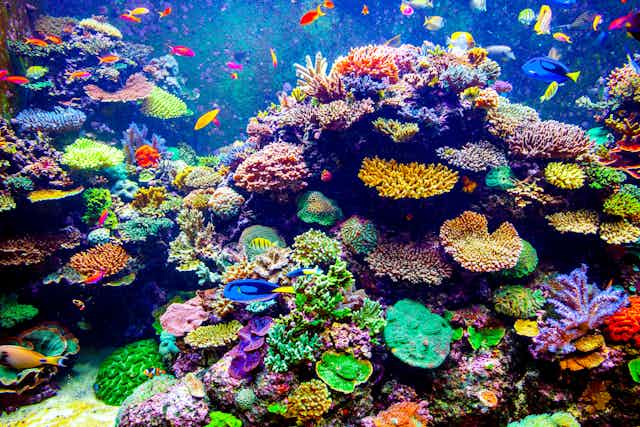Our coral reefs are under threat. Around the world, the long-term survival of reefs is in question because of the environmental stress that climate change is placing on them. But some corals appear to be more resilient to this stress than others. Understanding how these corals are different may hold the key to better predicting how reefs will fare in the future, and perhaps even finding ways to help protect them.
Tropical coral reefs are probably the most biodiverse ecosystems in the oceans, and support fishing industries and tourism to the value of US$36 billion a year. But when corals are exposed to an environmental stress such as a sharp increase in temperature, the relationship corals have with the various species of microalgae that live inside their tissues can break down. These algae are expelled, leaving the coral devoid of colour and, more importantly, its food source.
These “bleached” corals aren’t yet dead and can recover if they regain their algae quickly enough. Otherwise, corals essentially starve to death. Unfortunately for corals, sharp increases in temperature, known as “marine heatwaves”, are expected to become more frequent and severe because of human-caused climate change.
Coral bleaching has received a lot of media attention in recent years, often with dire predictions for the future survival of coral reef ecosystems. But there is hope.
Recent research has shown that coral bleaching has long occurred naturally, since well before human industry began warming the climate. Importantly, the corals analysed in this study recovered after each bleaching event, providing hope that corals today could survive even repeated bleaching events.
But the study also found that both the percentage of corals bleaching and number of years in a decade that bleaching occurs has been increasing since the 1800s. If this trajectory continues, there may come a time when recovery from bleaching is not possible.

Another source of hope are coralliths, free-living mobile corals that are common in many reefs around the world, but whose physiology has only recently been investigated. These corals are typically found in areas of reef not otherwise considered favourable for coral growth such as rubble patches. It turns out that these species are physiologically different from their stable counterparts and better at responding to acute environmental change.
We also know that there are some species of algae that are more resilient to ocean warming. For example, corals that bond with Durusdinium algae are less likely to bleach.
Coral transplants
Our knowledge about these kinds of hardy corals is growing, perhaps because their presence on reefs is becoming more obvious as attention over bleaching events increases. But what can we do with this knowledge? One option being trialled on reefs around the world is transplantation. Fragments or larvae of hardy corals are grown in nurseries and then planted out on a reef by divers.
The problem is transplantation is incredibly labour intensive and the transplanted corals often don’t survive very long. While it might be option for smaller reefs and for increasing public awareness, transplantation is unlikely to be a feasible way of restoring large reef areas.
Read more: 3D printing coral reefs can create new habitat – but it doesn't tackle human destruction
Another approach may be to manipulate the strains of algae associated with the corals to make them and the corals more tolerant to the stress of climate change. However, the rate of success of getting corals to take on new types of algae varies, and it’s a difficult job to say the least.
Corals have a long evolutionary history, and even in today’s rapidly changing climate some display a remarkable resilience to environmental stressors such as warming events. This should give us hope for their continued survival. But the greater the warming, the smaller the window of resilience.
Rather than providing a cure to bleaching, these kind of measures to restore coral reefs are dealing with the symptoms. For the long-term survival of coral reefs, we still need to take more action to deal with climate change and limiting the extent of global warming over the next 50 to 100 years.

